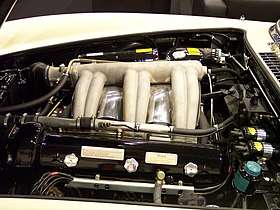Mercedes-Benz M186 engine
The Mercedes Benz M186 Engine was a 3.0–litre single overhead camshaft inline-6 developed in the early 1950s to power the company's new flagship 300 "Adenauer" (W186) four-door saloon. It made its debut at the Frankfurt Motor Show in April 1951.
| Mercedes-Benz M186 engine | |
|---|---|
 | |
| Overview | |
| Production | 1951–1967 |
| Layout | |
| Configuration | inline-6 |
| Displacement | 3.0 L; 182.8 cu in (2,996 cc) |
| Cylinder bore | 85 mm (3.35 in) |
| Piston stroke | 88 mm (3.46 in) |
| Head material | Aluminum |
| Valvetrain | SOHC 2 valves x cyl. |
| RPM range | |
| Redline | 6000[1] |
| Combustion | |
| Fuel system | 3 downdraft Solex carburettors Bosch Fuel injection |
| Fuel type | Gasoline |
| Cooling system | Water-cooled |
| Output | |
| Power output | 115–212 bhp (86–158 kW) |
| Torque output | 275 N⋅m (203 lb⋅ft) (M198 300 SL) |
Designed to give reliable service under prolonged hard use, the iron block/aluminum head engine featured deep water jackets, an innovative diagonal head-to-block joint that allowed for oversized intake and exhaust valves, thermostatically controlled oil cooling, copper-lead bearings, and a hardened crankshaft.
Variants of the M186 went on to be used in the exclusive 300 S/300 Sc gran tourer, iconic gullwing 300SL sports car, and Mercedes top-end 300-series sedans and limousines, and coupes of the early to mid-1960s. Production ended in 1967, four years after the introduction of the 600 Grosser Mercedes and its extremely powerful 6.3 L (386.4 cu in) M100 V-8.
The various versions of the engine (M186 – M199) produced from 115–240 bhp (86–179 kW) as compression ratios rose and the number of carburettors multiplied or were replaced with fuel-injection.[2]
While sharing many design features with Mercedes' 2.2 L (134 cu in) M180 engine introduced at the same show (such as staggered valve arrangement and rockers running off a single overhead camshaft driven by a duplex cam-chain), the two were of completely different design with little or no inter-changeability of parts.[3]
The term "big six" is sometimes used to distinguish the large block 3.0 L M186 from the small block M180 and its derivatives.
M186 Variants
M186
The 3.0–litre (2,996 cc (3.0 L; 182.8 cu in)) M186 was introduced in 1951 for use in the company's flagship 300 "Adenauer" (W186) four-door saloon. It had a slightly under-square bore and stroke of 85 mm × 88 mm (3.35 in × 3.46 in), featured an overhead cam, and an aluminum head with an innovative 30-degree diagonal head-to-block joint that allowed for oversized intake and exhaust valves. Designed to give reliable service under prolonged hard use, the engine featured deep water jackets, thermostatically controlled oil cooling, copper-lead bearings, and a hardened crankshaft. Fitted with twin downdraft Solex carburettors it produced 115 bhp (117 PS; 86 kW)[4] at a 6.4:1 compression ratio.
M188
The W188 300 S coupé/cabriolet was released in 1952 with the M188 variant, being fed by triple downdraft Solex carburettors and producing 150 hp (112 kW) at 5000 rpm and 7.8:1 compression ratio.
M189
The first M189 appeared in the 300d pillarless limousine of 1957, three years after the M198. It used Bosch indirect fuel injection to up performance from the underpowered M186 to 180 PS (132 kW; 178 hp) at 5500 rpm.[5] The engine then appeared in the Mercedes-Benz W112 300SE of 1961 and its long wheelbase SEL variant two years later. From 1964, power output was 170 hp (127 kW). The final incarnation of the M189 was in the W108 300SEb and W109 300SEL of 1965–1967, producing 170 hp (127 kW).
M198

The high-performance M198 was created in 1954 for the first generation of the 300SL, known colloquially as the "Gullwing". To fit under its low profile hood the engine was tilted 50-degrees to the left.[6][7] The result for the car was aerodynamic efficiency, and an enormous sand-cast aluminum intake manifold that stretched across the engine's entire breadth.[8] In order to deliver track-ready performance, race-derived features were built in, including a dry sump lubrication system and Bosch mechanical direct fuel-injection, a first for a production car. This engine produced 215 PS (158 kW; 212 hp) DIN net at 5,800 rpm and 275 N⋅m (203 lb⋅ft) DIN net of torque at 4,600 rpm[1] and 243 PS (179 kW; 240 hp) net (brake hp) at 6,100 RPM and 294 N⋅m (217 lb⋅ft) net torque at 4,800 RPM. An optional high-performance "Sport" camshaft was also available. This was the only available configuration for the Roadster version of the 300 SL when it made its debut in 1957.[1] Production ended in 1964.
M199
A significantly detuned direct-injection, standard oil system engine was used in the W188 300 Sc of 1955 to 1958 producing 175 hp (130 kW)
References
- Zal, Pawel. "1954 Mercedes-Benz 300 SL opt. 3.42 axle". Automobile-catalog.com. Retrieved 2018-12-08.
- http://wiki.mercedes-benz-classic.com/ Mercedes-Benz classic wiki
- Six Appeal, Mercedes Enthusiast, May 2007, pp 52–58
- http://wiki.mercedes-benz-classic.com/ Mercedes-Benz classic wiki
- Jeff Miller (2002-03-02). "Mercedes-Benz Type 300 "Adenauer" limousine © www.mbzponton.org". Mbzponton.org. Retrieved 2010-10-01.
- Mercedes 300 SL Technical data booklet (MB order no. 6510 1257 00 ed.). Daimler-Benz Aktiengesellschaf. 1957.
- Mercedes-Benz Workshop Manual Type 300SL. Daimler-Benz Aktiengesellschaf. 1956.
- 1957-’63 Mercedes-Benz 300 SL Roadster, hemmings.com